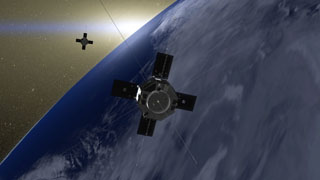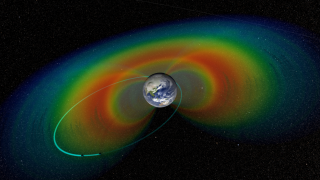Built To Last
NASA's Radiation Belt Storm Probes (RBSP) satellites were launched into space just before dawn on August 30, 2012. The mission was designed like none before it to penetrate and observe the Van Allen Belts, two dynamic swaths of radiation surrounding Earth that can wreak havoc on spacecraft electronics and potentially harm astronauts. Most satellites are put into orbit above or below the belts for protection. But, with thick aluminum shielding sensitive instruments, the twin RBSP satellites were built to go into the heart of the harshest radiation anywhere around Earth. As the belts vary unpredictably in size and intensity, the two identical spacecraft will provide multiple vantage points of these changes and ultimately lead to a better understanding of how energy from the sun affects the fluctuations. The visualization shows how the spacecraft will fly in an unusual, highly elliptical orbit to collect data throughout the vastness of the Van Allen Belts.

Two spacecraft have been launched directly into swaths of radiation where most fear to fly.
The highly elliptical orbit paths will take the spacecraft as close as 335 miles above Earth to as far as 20,000 miles away from the surface.

The two spacecraft were stacked prior to their launch on a single Atlas V 401 rocket.

Sealed inside the payload fairing, the spacecraft were ready for their spot atop the rocket.

The Atlas V 401 lifted off before dawn on Aug. 30, 2012 from Florida's Cape Canaveral Air Station.

An artist's rendition shows the twin spacecraft, attached to the Centaur stage of the rocket, just before deployment into orbit.
For More Information
See NASA.gov
Credits
Please give credit for this item to:
NASA's Goddard Space Flight Center
Launch photos courtesy of NASA HQ
Artist's rendition of Centaur stage courtesy of NASA/Johns Hopkins University Applied Physics Laboratory
-
Animators
- Chris Meaney (HTSI)
- Tom Bridgman (Global Science and Technology, Inc.)
-
Video editors
- Genna Duberstein (USRA)
- Scott Wiessinger (USRA)
-
Producers
- Scott Wiessinger (USRA)
- Genna Duberstein (USRA)
-
Scientists
- David G. Sibeck (NASA/GSFC)
- Shrikanth G. Kanekal (NASA/GSFC)
-
Writer
- Karen Fox (ADNET Systems, Inc.)
Release date
This page was originally published on Tuesday, September 11, 2012.
This page was last updated on Wednesday, May 3, 2023 at 1:52 PM EDT.

